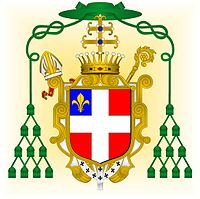
Peter of Savoy (French : Pierre de Savoie; died November 1332) was a member of the House of Savoy and a prelate of the 14th century.

Peter of Savoy (French : Pierre de Savoie; died November 1332) was a member of the House of Savoy and a prelate of the 14th century.
Peter was the son of Count Thomas III of Piedmont and his wife Guia de Bourgogne. [1] His date of birth is unknown. He is mentioned along with his brothers in his father's will dated 14 May 1282 ("Philippum de Sabaudia filium meum primogenitum [...] aliis filiis meis Petro, Thomæ, Amedeo et Guillermo fratribus suis"), as well as in a charter of 24 May 1286 ("Philippi Petri Thome Amedei et Guillelmi"). In 1304, he was dean of Salisbury Cathedral and a canon at Lyon.
In December 1307, Peter was appointed Archbishop of Lyon and Primate of Gaul. [2] Unlike his predecessor, Louis de Villars, Peter did not accept the gradual takeover of Lyon by the kingdom of France. He therefore encouraged the residents to revolt, [3] and encouraged them to strengthen the city walls, and he put aside the historical dispute between the archbishop and the cathedral chapter, [4] and challenged the presence of the "gardiateur" (overseer) imposed by the king of France, Philip the Fair, thus providing a pretext for Philip to send his son Louis, King of Navarre, and his brother Charles of Valois with an army to besiege Lyon in 1310.
The war ended with the intervention of the Peter's uncle, Amadeus V, Count of Savoy, who reluctantly sided with the French king to avoid becoming the king's next victim. [5] A treaty was signed on 10 April 1312, by which the archbishop lost control of the administration of justice in Lyon to the king, and was obliged to agree to the incorporation of Lyon into the kingdom of France. A definitive treaty of 4 April 1320 with the new king, Philip V, restored the jurisdiction of the city to the archbishop, but under royal sovereignty. The people of Lyon received several franchises, such as the right to set taxes for the benefit of the city.
However, the king refused the archbishop's demands for compensation for the depredations of the royal troops during the siege, both for their mistreatment of the inhabitants and particularly of the clergy. These were the subject of two written memoranda, one composed by the clerics of Lyon between the opening of the Council of Vienne on 16 October 1311 and the treaty of 10 April 1312, called Gravamina or Grauamina, the other by the prosecutor of the bailiff of Mâcon, between this treaty and the end of 1312, called Avisamenta. [6] The first sought to demonstrate the enormity of the royal depredations, setting the cost of them at 150,000 livres tournois ; the second, on the contrary, minimized them, putting the cost at only 10,000 livres tournois. Of this, the royal treasury only paid 2,000 livres, to which the king added, by "royal munificence" (Latin : sua munificentia regalis) 500 more. [7] These compensations, such as they were, were paid to the archbishop on 27 December 1312.
Also during his term of office Chazeaux Abbey was founded for a community of Poor Clares at Firminy. In 1316, the archbishop saw the election and coronation of Pope John XXII in Lyon.
Peter had an illegitimate son by an unknown mother:
Humbert I, better known as Humbert the White-Handed or Humbert Whitehand, was the count of Savoy from 1032 until his death and the founder of the House of Savoy.

Vienne is a town in southeastern France, located 35 kilometres (22 mi) south of Lyon, at the confluence of the Gère and the Rhône. It is the fourth-largest commune in the Isère department, of which it is a subprefecture alongside La Tour-du-Pin. Vienne was a major centre of the Roman Empire under the Latin name Vienna.

Robert II was Duke of Burgundy between 1272 and 1306 as well as titular king of Thessalonica.
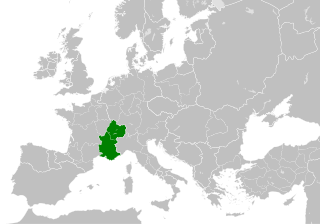
The Kingdom of Burgundy, known from the 12th century as the Kingdom of Arles, was a realm established in 933 by the merger of the kingdoms of Upper and Lower Burgundy under King Rudolf II. It was incorporated into the Holy Roman Empire in 1033 and from then on was one of the empire's three constituent realms, together with the Kingdom of Germany and the Kingdom of Italy. By the mid-13th century at the latest, however, it had lost its concrete political relevance.
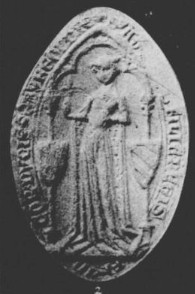
Agnes of France was Duchess of Burgundy by marriage to Robert II, Duke of Burgundy. She served as regent of Burgundy during the minority of her son's reign in 1306–1311.

Louis Rendu was a French Roman Catholic bishop of Annecy and a scientist.

The Diocese of Valence (–Die–Saint-Paul-Trois-Châteaux) (Latin: Dioecesis Valentinensis ; French: Diocèse de Valence is a Latin Church diocese of the Catholic Church in southern France. The contemporary diocese is co-extensive with the department of Drôme.
Louis of Savoy, Count of Geneva from 1460, became King of Cyprus in 1459 upon his second marriage to Charlotte of Cyprus, reigning together with and in the right of his wife until 1464. He was the second son and namesake of Louis, Duke of Savoy and his wife, Anne of Lusignan, daughter of King Janus of Cyprus.

The Archdiocese of Chambéry, Saint-Jean-de-Maurienne, and Tarentaise is a Latin Church archdiocese of the Catholic Church in France and a suffragan of the Archdiocese of Lyon. The archepiscopal see is Chambéry Cathedral, located in the city of Chambéry. The archdiocese encompasses the department of Savoie, in the Region of Rhône-Alpes.

The French Roman Catholic diocese of Saint-Jean-de-Maurienne has since 1966 been effectively suppressed, formally united with the archdiocese of Chambéry. While it has not been suppressed, and is supposed to be on a par with Chambéry and the diocese of Tarentaise, it no longer has a separate bishop or existence.

Mouxy is a commune in the Savoie department in the Auvergne-Rhône-Alpes region in south-eastern France.
Geneviève Hasenohr is a French philologist and prolific scholar of medieval and Renaissance French literature. She has authored or contributed to more than forty books, written at least fifty academic articles and reviews, and prepared numerous scholarly editions.
Guichard, also known under the name of Guichard of Pontigny was a French churchman, Archbishop of Lyon from 1165.
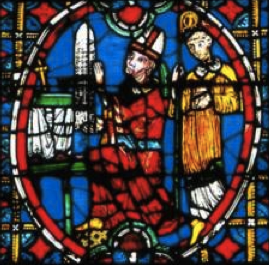
Renaud de Forez was a French churchman who was Archbishop of Lyon as Renaud II (1193–1226). A son of Count Guigues II of Forez, Renaud acted as regent of the county of Forez for his nephew, Guigues IV, between 1203 and 1218. He joined the Lyon chapter during the episcopate of Guichard of Pontigny. He became abbot of Saint-Just in 1182.

The Diocese of Geneva was a Latin Church ecclesiastical jurisdiction or diocese in part of Switzerland and Savoy from 400 to 1801, when it merged with the Diocese of Chambéry. The merged diocese was later broken up, due to changes in national boundaries. The diocese of Chambéry lost Swiss territory to the Diocese of Lausanne, Geneva and Fribourg.
Ermengarde was a medieval noblewoman. Through her first marriage, to Rotbold II, Count of Provence, she was countess of Provence, and from 1011 to 1032 Ermengarde was the last queen of independent Burgundy by virtue of her second marriage to Rudolf III of Burgundy.

Charles de Grandmaison was a French archivist and historian.
The history of Savoy presents a synthesis of the various periods, from prehistory to the present day, of the geographical and historical entity known as Savoy, a territory whose definition has varied over the course of historical periods, until it was defined by the two French departments of Savoie and Haute-Savoie.
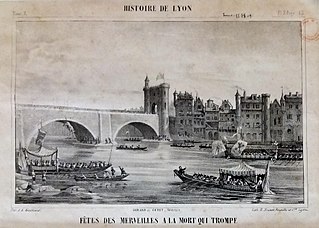
The Feast of Wonders or Feast of Miracles is both a religious and pagan ceremony that took place in Lyon on the banks of the Saône during part of the Middle Ages. It is inextricably linked with Saint Pothin's Day, a day of homage to the martyrs of Lyon in 177.

The term annexation of Savoy to France is used to describe the union of all of Savoy—including the future departments of Savoy and Haute-Savoie, which corresponded to the eponymous duchy—and the County of Nice, which was then an integral part of the Kingdom of Sardinia, with France in 1860. This union is expressed in the French version of the Treaty of Turin.